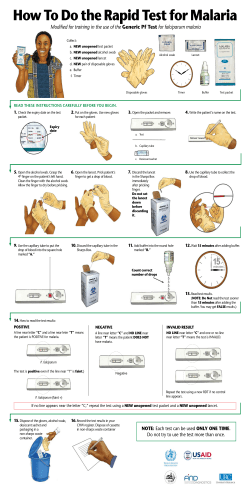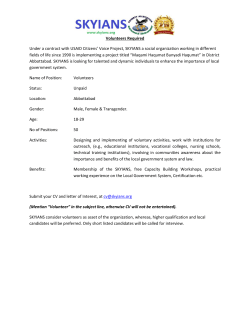
Behaviour Change Communication with Mobile Populations APMEN
Behaviour Change Communication with Mobile Populations APMEN VII Hoi An, Vietnam 25-27 March 2015 Behaviour Change Communication with Mobile Populations Muhammad Shafique APMEN Business and Technical Meeting, 25-27 March 2015, Hoi An, Vietnam Structure of presentation • Concept of Positive Deviance (PD) • Intervention details • Evaluation / key results • Lessons learned • Next steps Positive deviance Concept In every community there are certain individuals whose uncommon positive behaviours enable them to find better solutions to problems than their neighbours who have access to the same resources Why PD in Greater Mekong sub-Region ► Focus is from control to elimination • As the malaria programme strategy shifts from control to elimination, it requires focused and effective community engagement approaches to ensure the participation and enthusiasm of communities in health programmes ► PD helps understand the context • As we are targeting hard to reach mobile and migrant, ethnic populations, it very important to understand their context to better reach out to them ► Interpersonal communication (IPC) • IPC as the most preferred communication method in the region. PD is the best alternative to IPC as it engages and empower communities by considering them an equal partner in the programme Positive deviance pilot villages PD baseline-endline pilot evaluation in six villages of Kyun Su Island, Myanmar ► Population: 7,000 ► March 2013 to March 2014 ► Selection criteria • High risk MARC area • Presence of high risk population rubber tappers/fisher men • Presence of village volunteers Objectives • To describe the practical application of a positive deviance (PD) informed pilot project on high risk community members, rubber tappers and fishermen • To orient the National Malaria Control Programme, Myanmar and key partners on the PD approach • To conduct evaluation of positive deviance approach using both quantitative and qualitative methods • To document the process and lessons learned to share with national malaria programmes and key stakeholders/partners Positive deviance process Step 1 • Community orientation Step 2 • Situation analysis Step 3 • PD inquiry Step 4 • Community feedback session Step 5 • Train volunteers Step 6 • Volunteers share positive deviant’s strategy with village PD process (1 week) 1. Community orientation • Invite community members • Explain PD concept through games and stories • Promise to assemble again in a week with solution 2. Situation analysis • Conduct focus group discussions • Establish normative behaviours of community around malaria • Identify potential positive deviants through FGDs PD process (1 week) cont… 3. PD inquiry: • In-depth interviews with potential PD role models (male/female) • Identify successful PD behaviours and strategies 4. Feedback session: • Conduct at the end of PD process to share the identified PD behaviours with large community • Share PD findings through interactive role plays • Identify volunteers Example of positive deviance role model behaviours A female rubber tapper who works in a rubber farm for 15 years but has never had malaria: • She always wears a long-sleeved shirt, long trousers and rubber boots when she works in the rubber farm • She covers her head and face with a cloth during rubber tapping to avoid mosquito bites • When she is at home, she always sleeps under the LLIN • Burns coil when cooking/watching TV • Whenever gets sick, she always contacts the volunteer for blood test PD implementation (1 year) • Training of volunteers • PD sessions o Monthly interactive sessions • Monthly volunteers meetings o Progress review o On job training of volunteers • Participatory monitoring o Using maps • PD seminar o Acknowledgement of volunteers o Handing over the project to communities Evaluation Evaluation methodology • Data collected at baseline (March 2013) and endline (March 2014) • Quantitative data • Household survey of 462 (baseline) and 496 (endline) households • Qualitative data • 12 focus group discussions and 10 in-depth interviews Results All findings presented are statistically significant at level .05 or below Key finding 1: Behaviour change communication coverage Increases in behaviour change communication (BCC) coverage were largely attributable to the PD intervention. Data • BCC coverage increased from 15.9% to 63.0% • i.e. receiving any malaria messages/information in past six months • Increases in coverage were mostly due to increases in messages from health workers • 40.7% of respondents received information from village health volunteers (VHVs)/ health facility staff at endline, compared to 10.6% at baseline Percentage heard BCC messages Behaviour change communication coverage and its source 70 60 16.1 50 Other 6.2 40 NGO staff 30 40.7 20 10 0.6 4.7 10.6 0 Baseline Endline VHV/Health Facility Staff Key finding 2: Knowledge Knowledge about malaria risks, symptoms, prevention methods and treatment increased. Data Knowledge Baseline Endline Mosquito bites cause malaria 76.3% 93.3% Sleeping under insecticide treated net can prevent malaria 55.6% 78.6% Fever is a symptom of malaria 55.2% 84.1% Antimalarials must be taken for three days 40.3% 50.6% Person may not recover if they don’t complete treatment 27.6% 45.2% Key finding 3: Attitudes Attitudes towards village health volunteers improved. Data • Over time, VHVs became the second most important source of malaria advice or treatment and testing • At endline 30.6% of households would go to VHVs for malaria advice or treatment, compared to 11.4% at baseline • Rural health centers, however, remained the primary sources of advice, testing and treatment • 46% (baseline) -49% (endline) would go there for malaria advice or treatment • Reduction possibly because people more likely to go to VHV first Preferred sources of malaria advice and treatment Baseline Endline 23.4 39.3 46 49.3 VHV 30.6 11.4 Rural Health Center Other Key finding 4: Practices Prevention practices among women, fishermen and forest-goers improved. Data Practices Baseline Endline Bed net usage among women 69.9% 78.4% Wearing of long clothes among forest-goers 24.2% 49.3% Wearing of long clothes among fishermen 18% 36.7% Lessons learned ► Strong community mobilization tool • ► PD can be a model to promote community ownership and sustainability of health interventions Fills in the formative research gap • PD process helps understand context, normative behaviours, effective channels ► An effective alternative to traditional IPC methods ► Hard to reach, ethnic group or isolated populations (elimination settings) • It works well with the communities of strong sense of belonging Lessons learned cont… ► PD could be applied to other areas • ► PD approach could be applied in other areas such as public health facilities, private clinics and private health providers to improve the use of malaria services. Require some basic facilitation skills • ► PD is a human intensive (PD process) and requires some facilitation skills Scaling up • PD approach can be scaled up through capacity building of provincial, district malaria staff and volunteers Next steps ► PD on dengue prevention • A Cluster Randomised Trial is being conducted in 24 villages including an entomological component to evaluate PD on dengue in Hinthada Township, Ayeyarwaddy, Myanmar. ► A large scale PD evaluation on malaria in Myanmar • A large scale PD evaluation on malaria is planned in Myanmar in June 2015. • Concept note • Ethical process Acknowledgements ► National Malaria Control Programme, Cambodia, Myanmar and Thailand • Dr. Thar Tun Kyaw, Dr Thaung Hlaing ► Myanmar Medical Association (MMA) • Dr. Myo Min ► Positive Deviance Initiative, Tufts University • Ms. Monique Sternin ► Department for International Development/Ukaid Thank you www.malariaconsortium.org
© Copyright 2025










